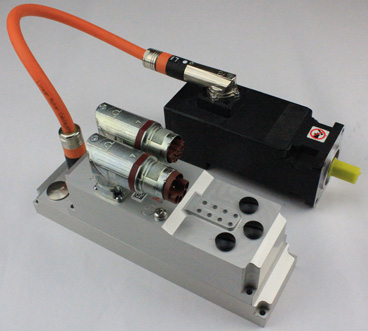 I controllori Robox possono gestire qualunque applicazione, grazie alla varietà di bus di campo su cui comunicano, tra cui Ethercat, CANopen, profibus e modbus
I controllori Robox possono gestire qualunque applicazione, grazie alla varietà di bus di campo su cui comunicano, tra cui Ethercat, CANopen, profibus e modbus
ROBOX, da oltre 45 anni, sviluppa e produce controlli asse, linguaggi di programmazione ed ambienti di sviluppo ideali per la robotica e in generale per il “motion control”. La molteplicità dei linguaggi di programmazione (testo strutturato, ladder, object blocks) e la ricchezza delle librerie rendono facile l’apprendimento dei sistemi Robox per qualunque ragazzo volenteroso e con le giuste basi di elettronica e informatica provviste dall’istruzione superiore italiana.
I controllori Robox possono gestire qualunque applicazione, grazie alla varietà di bus di campo su cui comunicano, tra cui Ethercat, CANopen, profibus e modbus. L’attuale prodotto di punta è l’RP2: il cervello elettronico marchiato Robox con tecnologia ARM e compatibile con gli I/O Axioline della Phoenix Contact.
Proprio come i suoi predecessori (tra cui ricordiamo RBXM, uRMC3 e RP1), l’RP2 sta rapidamente conquistando un posto rilevante nella robotica e nell’automazione industriale, con adozioni sempre crescenti nell’ambito di varie macchine, come impacchettatrici (flowpack), riempitrici, tappatrici e cartonatrici.
I tool software messi a disposizione da RDE (l’ambiente di sviluppo Robox) permettono di gestire la configurazione, scrivere il programma, simulare la macchina a banco e anche di avere una visione del sistema, grazie ai pannelli grafici 3D. Questo strumento permette di modellizzare e simulare le parti più critiche della macchina, dare un’occhiata ai loro movimenti e debuggare il sistema.
Anche l’integrazione tra sistemi di controllo e drives è notevolmente aumentata. Sul fronte degli sviluppi hardware, citiamo l’azionamento RID20-E che ha sostituito l’azionamento RID20. Ricordiamo che RID20 è un azionamento progettato (2008) per essere installato direttamente sul motore, condividendone il mondo termico. RID20, a distanza di 14 anni dalla sua nascita, è ben lungi dall’essere obsoleto. Ugualmente si è proceduto ad una riprogettazione – il RID20-E – per godere degli sviluppi della tecnica durante questi anni.
RID20-E pertanto è caratterizzato da rendimenti migliori, frequenze di funzionamento degli anelli di regolazione più alte, I/O arricchiti, strumenti di indagine più potenti, ecc.
RID20-E è disponibile in una versione atta all’installazione diretta sul motore (configurazione shuttle) e in una versione atta ad essere posto nelle immediate vicinanze del motore (configurazione nearby). Grazie all’integrazione con il motore, RID20-E si presta all’impiego in tutte le applicazioni multiasse che richiedono drastiche riduzioni dimensionali e di cablaggi, quali ad esempio le applicazioni nei settori beverage”, alimentare e “packaging”.
www.robox.it
Motion control for over 45 years
Robox controllers can handle any application, thanks to the variety of fieldbuses they communicate on, including Ethercat, CANopen, profibus and modbus
ROBOX, for over 45 years, has been developing and producing axis controls, programming languages and development environments ideal for robotics and for “motion control” in general. The multiplicity of programming languages (structured text, ladder, object blocks) and the richness of the libraries make learning Robox systems easy for any willing boy with the right basics of electronics and information technology provided by Italian higher education.
Robox controllers can handle any application, thanks to the variety of fieldbuses they communicate on, including Ethercat, CANopen, profibus and modbus. The current flagship product is the RP2: the Robox branded electronic brain with ARM technology and compatible with Phoenix Contact’s Axioline I/Os.
Just like its predecessors (including the RBXM, uRMC3 and RP1), the RP2 is rapidly gaining a significant place in robotics and industrial automation, with ever-increasing adoptions in various machines, such as flowpackers, fillers, cappers and case packers.
The software tools made available by RDE (the Robox development environment) allow you to manage the configuration, write the program, simulate the machine on the bench and also have a view of the system, thanks to the 3D graphic panels. This tool allows you to model and simulate the most critical parts of the machine, take a look at their movements and debug the system.
The integration between control systems and drives has also increased significantly. In terms of hardware developments, we mention the RID20-E drive which replaced the RID20 drive. We recall that RID20 is a drive designed (2008) to be installed directly on the motor, sharing its thermal world. RID20, 14 years after its birth, is far from obsolete. We also proceeded with a redesign – the RID20-E – to take advantage of the developments of the technique during these years.
RID20-E is therefore characterized by better yields, higher operating frequencies of the regulation loops, enriched I/Os, more powerful investigation tools, etc.
RID20-E is available in a version suitable for direct installation on the motor (shuttle configuration) and in a version suitable for being placed in the immediate vicinity of the motor (nearby configuration). Thanks to the integration with the motor, RID20-E is suitable for use in all multi-axis applications that require drastic reductions in size and wiring, such as for example applications in the “beverage”, food and “packaging” sectors.
www.robox.it











